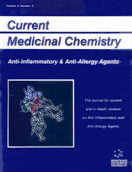Abstract
Nitric oxide (NO) and inflammation interact at many levels. First, NO produced in low, physiological levels by vascular endothelial cells under the control of the constitutive endothelial nitric oxide synthase (eNOS) tends to inhibit endothelial-leucocyte interactions. Thus, pharmacologic interventions, which block eNOS are counterproductive in inflammatory diseases. Second, inflammation is characteristically associated with the stimulated expression of the inducible isoform of nitric oxide synthase (iNOS), leading to production of large amounts of NO for extended period of time in many cell types. These large amounts of NO potentially contribute to tissue damage through the generation of toxic reactive nitrogen species such as higher nitrogen oxides and peroxynitrite. Therefore, it could be of therapeutic value to selectively inhibit iNOS, while leaving intact the activity of eNOS. In recent years, considerable progress has occurred in the molecular design of highly potent and highly selective inhibitors of iNOS. However, effects of these agents in specific disease conditions is not readily predictable, because the interactions of NO and inflammation are considerably more intricate than just indicated. For example, the activation of nuclear factor kappa B (NF-κB), an essential pathway for induction of an inflammatory cellular phenotype, may either by enhanced or inhibited by NO, depending on particular conditions. In addition, NO has a complex influence on the production of inflammatory prostanoids. NO is also a player in acquired immunity, for example by tilting the Th1 / Th2 balance in favour of Th2 responses. Finally, NO is an important effector in the defense against at least some invading pathogens. Here we provide a detailed review of efforts made at characterizing the effects of disrupting the function of iNOS, by either genetic or pharmacologic means, in three classes of experimental paradigms: 1) models of arthritis, 2) models of inflammatory bowel disease, and 3) models of generalized inflammation induced by endotoxemia or bacterial sepsis. The accrued evidence in each of these cases suggests that the contribution of NO to pathophysiology of inflammatory diseases is highly heterogeneous, and therefore difficult to target therapeutically by the presently available means.
Keywords: nitric oxide, inflammation, arthritis, colitis, sepsis, experimental model, knockout mice, nitric oxide synthase inhibitors
 4
4

